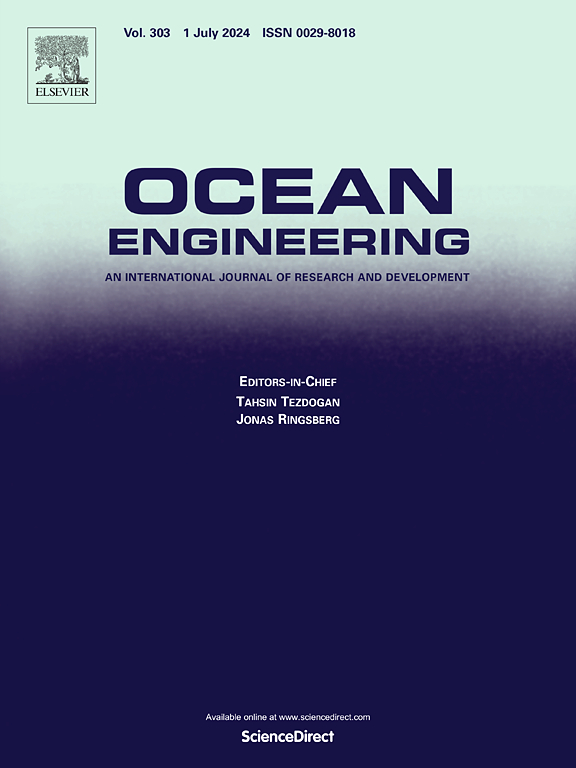Influence of hull geometry on self-propulsion performance of vector-propelled streamlined AUV with a ducted propeller
IF 4.6
2区 工程技术
Q1 ENGINEERING, CIVIL
引用次数: 0
Abstract
Vector-propelled streamlined autonomous underwater vehicles (AUVs) have attracted considerable attention owing to their superior maneuverability. This study investigates the influence of hull geometry on the self-propulsion performance of a vector-propelled streamlined AUV with a ducted propeller. Firstly, the numerical models for both vector-propelled streamlined AUVs and ducted propellers are presented. Secondly, a novel self-propulsion prediction method is developed using computational fluid dynamics (CFD) and an overset mesh technique. This method is validated using a model experiment. Finally, self-propulsion simulations are conducted under horizontal, vertical, and spatial motion conditions. The effects of the head length, head shape index, and length-to-diameter ratio on the self-propulsion performance are discussed. The results show that: (1) the head shape index affects the hydrodynamic drag in the surge direction during horizontal turning, whereas the length-to-diameter ratio affects the drag in the sway and yaw directions. (2) During vertical turning, the head shape index affected the drag in the surge direction, and the length-to-diameter ratio affects the drag in the heave and pitch directions. (3) The length-to-diameter ratio significantly affects turning diameter, period, and vertical pitch during spatial motion. As the length-to-diameter ratio increases, the hydrodynamic drag increases in the surge, heave, sway, and yaw directions.
船体几何形状对导管式矢量推进流线型水下航行器自推进性能的影响
矢量推进的流线型自主水下航行器(auv)因其优越的机动性而备受关注。本文研究了船体几何形状对带导管螺旋桨的矢量推进流线型水下航行器自推进性能的影响。首先,建立了矢量推进流线型水下机器人和导管式螺旋桨水下机器人的数值模型。其次,利用计算流体力学(CFD)和重叠网格技术,提出了一种新的自推进预测方法。通过模型实验验证了该方法的有效性。最后,在水平、垂直和空间运动条件下进行了自推进仿真。讨论了机头长度、机头形状指数和长径比对自推进性能的影响。结果表明:(1)水头形状指数影响水波方向的水动力阻力,而长径比影响横摆和偏航方向的水动力阻力。(2)垂向转弯时,头型指数影响浪涌方向阻力,长径比影响升沉和俯仰方向阻力。(3)在空间运动中,长径比显著影响转弯直径、周期和垂直节距。随着长径比的增加,水动力阻力在激波、升沉、摇摆和偏航方向上增加。
本文章由计算机程序翻译,如有差异,请以英文原文为准。
求助全文
约1分钟内获得全文
求助全文
来源期刊

Ocean Engineering
工程技术-工程:大洋
CiteScore
7.30
自引率
34.00%
发文量
2379
审稿时长
8.1 months
期刊介绍:
Ocean Engineering provides a medium for the publication of original research and development work in the field of ocean engineering. Ocean Engineering seeks papers in the following topics.
 求助内容:
求助内容: 应助结果提醒方式:
应助结果提醒方式:


